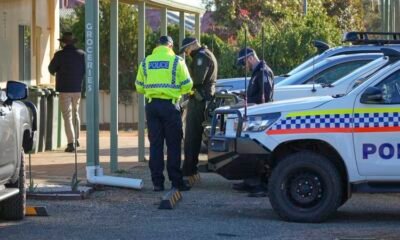Conflict Zones
Pahalgam attack: A simple guide to the Kashmir conflict | Border Disputes News

Islamabad, Pakistan – Pakistan and India continue to engage in war rhetoric and have exchanged fire across the Line of Control (LoC), the de facto border in Kashmir, days after the Pahalgam attack, in which 26 civilians were killed in Indian-administered Kashmir on April 22.
Since then, senior members of Pakistan’s government and military officials have held multiple news conferences in which they have claimed to have “credible information” that an Indian military response is imminent.
This is not the first time South Asia’s two largest countries – which have a combined population of more than 1.6 billion people, about one-fifth of the world’s population – have found themselves under the shadow of potential war.
At the heart of their longstanding animosity lies the status of the picturesque valley of Kashmir, over which India and Pakistan have fought three of their four previous wars. Since gaining independence from British rule in 1947, both countries have controlled parts of Kashmir – with China controlling another part of it – but continue to claim it in full.
So what is the Kashmir conflict all about, and why do India and Pakistan continue to fight over it nearly eight decades after independence?
What are the latest tensions about?
India has implied it believes Pakistan may have indirectly supported the Pahalgam attack – a claim Pakistan strongly denies. Both countries have engaged in tit-for-tat diplomatic swipes at each other, including cancelling visas for each other’s citizens and recalling diplomatic staff.
India has suspended its participation in the Indus Waters Treaty, a water use and distribution agreement with Pakistan. Pakistan has in turn threatened to walk away from the Simla Agreement, which was signed in July 1972, seven months after Pakistan decisively lost the 1971 war that led to the creation of Bangladesh. The Simla Agreement has since formed the bedrock of India-Pakistan relations. It governs the LoC and outlines a commitment to resolve disputes through peaceful means.
On Wednesday, United States Secretary of State Marco Rubio called Pakistani Prime Minister Shehbaz Sharif and Indian External Affairs Minister Subrahmanyam Jaishankar to urge both countries to work together to “de-escalate tensions and maintain peace and security in South Asia”.
US Defense Secretary Pete Hegseth also called Indian Defence Minister Rajnath Singh on Thursday to condemn the attack. “I offered my strong support. We stand with India and its great people,” Hegseth wrote on X.

What lies at the heart of the Kashmir conflict?
Situated in the northwest of the Indian subcontinent, the region spans 222,200 square kilometres (85,800sq miles) with about four million people living in Pakistan-administered Kashmir and 13 million in Indian-administered Jammu and Kashmir.
The population is overwhelmingly Muslim. Pakistan controls the northern and western portions, namely Azad Kashmir, Gilgit and Baltistan, while India controls the southern and southeastern parts, including the Kashmir Valley and its biggest city, Srinagar, as well as Jammu and Ladakh.
The end of British colonial rule and the partition of British India in August 1947 led to the creation of Muslim-majority Pakistan and Hindu-majority India.
At the time, princely states like Jammu and Kashmir were given the option to accede to either country. With a nearly 75 percent Muslim population, many in Pakistan believed the region would naturally join that country. After all, Pakistan under Muhammad Ali Jinnah was created as a homeland for Muslims, even though a majority of Muslims in what remained as India after partition stayed back in that country, where Mahatma Gandhi and independent India’s first prime minister, Jawaharlal Nehru, built the foundations of a secular state.
The maharaja of Kashmir initially sought independence from both countries but later chose to join India after Pakistan invaded, triggering the first war from 1947 to 1948. The ceasefire line established after that was formalised as the LoC in the Simla Agreement.
Despite this, both countries continue to assert claims to the entire region, including, in the case of India, to China-administered Aksai Chin on the eastern side.

What triggered the first Indo-Pakistan war in 1947?
The ruling Hindu maharaja of Kashmir was Hari Singh, whose forefathers took control of the region as part of an agreement with the British in 1846.
At the time of partition, Singh initially sought to retain Kashmir’s independence from both India and Pakistan.
But by then, a rebellion against his rule by pro-Pakistani residents in a part of Kashmir had broken out. Armed groups from Pakistan, backed by the government of the newly formed country, invaded and tried to take over the region.
Sheikh Abdullah, the most prominent Kashmiri leader at the time, opposed the Pakistani-backed attack. Hari Singh appealed to India for military assistance.
Nehru’s government intervened against Pakistan – but on the condition that the maharaja sign an Instrument of Accession merging Jammu and Kashmir with India. In October 1947, Jammu and Kashmir officially became part of India, giving New Delhi control over the Kashmir Valley, Jammu and Ladakh.
India accused Pakistan of being the aggressor in the conflict – a charge Pakistan denied – and took the matter to the United Nations in January 1948. A key resolution was passed stating: “The question of the accession of Jammu and Kashmir to India or Pakistan should be decided through the democratic method of a free and impartial plebiscite.” Nearly 80 years later, no plebiscite has been held – a source of grievance for Kashmiris.
The first war over Kashmir finally ended with a UN-mediated ceasefire, and in 1949, the two countries formalised a ceasefire line under an agreement signed in Karachi, Pakistan’s then-capital. The new line divided Kashmir between Indian- and Pakistani-controlled parts.
How did the situation change after the 1949 agreement?
By 1953, Sheikh Abdullah had founded the Jammu Kashmir National Conference (JKNC) and won state elections in Indian-administered Kashmir.
However, his increasing interest in seeking independence from India led to his arrest by Indian authorities. In 1956, Jammu and Kashmir was declared an “integral” part of India.
In September 1965, less than two decades after independence, India and Pakistan went to war over the region again.
Pakistan hoped to aid the Kashmiri cause and incite a local uprising, but the war ended in a stalemate, with both sides agreeing to a UN-supervised ceasefire.
How did China get a part of Kashmir?
The Aksai Chin region in the northeast of the region sits at an elevation of 5,000 metres (16,400 feet), and through history, was a hard-to-reach, barely inhabited territory that in the 19th and early 20th centuries sat at the border of British India and China.
It was a part of the kingdom that Kashmir’s Hari Singh inherited as a result of the 1846 deal with the British. Until the 1930s, at least, Chinese maps too recognised Kashmir as being south of the Ardagh-Johnson Line that marked the northeastern boundary of Kashmir.
After 1947 and Singh’s accession to India, New Delhi viewed Aksai Chin as part of its territory. But by the early 1950s, China – now under communist rule – built a massive 1,200km (745-mile) long highway connecting Tibet and Xinjiang, and running through Aksai Chin.
India was caught unaware – the desolate region had not been a security priority until then. In 1954, Nehru called for the border to be formalised according to the Ardagh-Johnson Line – in effect, recognising Aksai Chin as a part of India.
But China insisted that the British had never discussed the Ardagh-Johnson Line, and that Aksai Chin belonged to it under an alternate map. Most importantly, though, China already had boots on the ground in Aksai Chin because of the highway.
Meanwhile, Pakistan and China also had differences over who controlled what in parts of Kashmir. But by the early 1960s, they reached an agreement: China gave up grazing grounds that Pakistan had sought, and in return, Pakistan ceded a thin slice of northern Kashmir to China.
India claims this deal was illegal since, according to the Instrument of Accession of 1947, all of Kashmir belonged to it.
Back to India and Pakistan: What happened next?
Another war followed in December 1971 – this time over what was then known as East Pakistan, following a popular revolt by India-backed Bengali nationalists against Pakistan’s rule. The war led to the creation of Bangladesh. More than 90,000 Pakistani soldiers were captured by India as prisoners of war.
The Simla Agreement converted the ceasefire line into the LoC, a de facto but not internationally recognised border, yet again leaving Kashmir’s status in question.
But after India’s decisive 1971 victory and amid the growing political influence of Prime Minister Indira Gandhi – Nehru’s daughter – the 1970s saw Abdullah abandon his demand for a plebiscite and the Kashmiri people’s right of self-determination.
In 1975, he signed an accord with Gandhi, recognising India-administered Kashmir’s accession to India while retaining semi-autonomous status under Article 370 of the Indian Constitution. He later served as the region’s chief minister.
What led to a renewed drive for Kashmiri independence in the 1980s?
As ties grew between Abdullah’s National Conference Party and India’s ruling Indian National Congress, so did frustration among Kashmiris in India-controlled Kashmir, who felt that socioeconomic conditions had not improved in the region.
Separatist groups like the Jammu-Kashmir Liberation Front, founded by Maqbool Bhat, rose.
India’s claims of democracy in Kashmir faltered in the face of growing support for the armed groups. A tipping point was the 1987 election to the state legislature, which saw Abdullah’s son, Farooq Abdullah, come to power, but which was widely viewed as heavily rigged to keep out popular, anti-India politicians.
Indian authorities launched a severe crackdown on separatist groups, which New Delhi alleged were supported and trained by Pakistan’s military intelligence. Pakistan, for its part, has consistently maintained it provides only moral and diplomatic support, backing the Kashmiris’ “right to self-determination”.
In 1999, conflict erupted in Kargil, where Indian and Pakistani forces fought for control over strategic heights along the LoC. India eventually regained the lost territory, and the pre-conflict status quo was restored. This was the third war over Kashmir – Kargil is a part of Ladakh.
How have tensions over Kashmir escalated since then?
The following years saw a gradual reduction in direct conflict, with multiple ceasefires signed. However, India significantly ramped up its military presence in the valley.
Tensions were reignited in 2016 after the killing of Burhan Wani, a popular separatist figure. His death led to a rise in violence in the valley and more frequent exchanges of fire along the LoC.
Major attacks in Indian-administered Kashmir, including those in Pathankot and Uri in 2016, targeted Indian forces, who blamed Pakistan-backed armed groups.
The most serious escalation came in February 2019 when a convoy of Indian paramilitary personnel was attacked in Pulwama, killing 40 soldiers and bringing the two nations to the brink of war.
Six months later, the Indian government under Prime Minister Narendra Modi unilaterally abrogated Article 370, stripping Jammu and Kashmir of its semi-autonomous status. Pakistan condemned the move as a violation of the Simla Agreement.
The decision led to widespread protests in the valley. India deployed 500,000 to 800,000 soldiers, placed the region under lockdown, shut down internet services and detained thousands of people.
India insists that Pakistan is to blame for the ongoing crisis in Kashmir. It accuses Pakistan of hosting, financing and training the Pakistan-based armed groups that have claimed responsibility for multiple attacks in Indian-administered Kashmir over the decades. Some of these groups are also accused by India, the US, and others of attacking other parts of India – such as during the 2008 attack on Mumbai, India’s financial capital, when at least 166 people were killed over three days.
Pakistan continues to deny that it fuels violence in India-controlled Kashmir and instead points to widespread resentment among locals, accusing India of imposing harsh and undemocratic rule in the region. Islamabad says it only supports Kashmiri separatism diplomatically and morally.
Conflict Zones
US-backed GHF suspends Gaza aid for full day, names new evangelical leader | Israel-Palestine conflict News

Israeli military warns access roads to the Gaza Humanitarian Foundation’s (GHF) aid distribution sites are now considered ‘combat zones’.
The United States- and Israeli-backed Gaza Humanitarian Foundation (GHF) will suspend aid distribution in the war-torn territory on Wednesday, a day after Israeli forces again opened fire on Palestinian aid seekers near a GHF distribution site, killing at least 27 and injuring more than 100.
Israel’s military also said that approach roads to the aid distribution centres will be “considered combat zones” on Wednesday, and warned that people in Gaza should heed the GHF announcement to stay away.
“We confirm that travel is prohibited tomorrow on roads leading to the distribution centers … and entry to the distribution centers is strictly forbidden,” an Israeli military spokesperson said.
In a post on social media, GHF said the temporary suspension was necessary to allow for “renovation, reorganisation and efficiency improvement work”.
“Due to the ongoing updates, entry to the distribution centre areas is slowly prohibited! Please do not go to the site and follow general instructions. Operations will resume on Thursday. Please continue to follow updates,” the group said.
The temporary suspension of aid comes as more than 100 Palestinian people seeking aid have been reported killed by Israeli forces in the vicinity of GHF distribution centres since the organisation started operating in the enclave on May 27.
The killing of people desperately seeking food supplies has triggered mounting international outrage with United Nations Secretary-General Antonio Guterres demanding an independent inquiry into the deaths and for “perpetrators to be held accountable”.
“It is unacceptable that Palestinians are risking their lives for food,” Guterres said.
The Israeli military has admitted it shot at aid seekers on Tuesday, but claimed that they opened fire when “suspects” deviated from a stipulated route as a crowd of Palestinians was making its way to the GHF distribution site in Gaza.
Israel’s military said it is looking into the incident and the reports of casualties.
On Tuesday, GHF named its new executive chairman as US evangelical Christian leader Reverend Dr Johnnie Moore.
Moore, who was an evangelical adviser to the White House during the first term of United States President Donald Trump, said in a statement that GHF was “demonstrating that it is possible to move vast quantities of food to people who need it most — safely, efficiently, and effectively”.
The UN and aid agencies have refused to work with the GHF, accusing the group of lacking neutrality and of being part of Israel’s militarisation of aid in Gaza. Israel has also been accused of “weaponising” hunger in Gaza, which has been brought about by a months-long Israeli blockade on food, medicine, water and other basic essentials entering the war-torn territory.
Moore’s appointment is likely to add to concerns regarding GHF’s operations in Gaza, given his support for the controversial proposal Trump floated in February for the US to take over Gaza, remove the Palestinian population, and focus on real estate development in the territory.
After Trump proposed the idea, Moore posted video of Trump’s remarks on X and wrote: “The USA will take full responsibility for future of Gaza, giving everyone hope & a future.”
Responding on social media to UN chief Guterres’s outrage following the killing of aid seekers in Gaza on Sunday, Moore said: “Mr Secretary-General, it was a lie… spread by terrorists & you’re still spreading it.
The GHF’s founding executive director, former US marine Jake Wood, resigned from his position before the Gaza operation began, questioning the organisation’s “impartiality” and “independence”.
Critics have accused GHF, which has not revealed where its funds come from, of facilitating the Israeli military’s goal of depopulating northern Gaza as it has concentrated aid distribution in the southern part of the territory, forcing thousands of desperate people to make the perilous journey to its locations to receive assistance.
Conflict Zones
Five UN food aid workers killed in Sudan ambush as hunger crisis deepens | Sudan war News

Deadly attack on United Nations convoy in Sudan disrupts aid to hunger-stricken families in the war-torn country.
An ambush on a United Nations food aid convoy in Sudan has killed at least five people, blocking urgently needed supplies from reaching civilians facing starvation in the war-torn Darfur city of el-Fasher.
Aid agencies confirmed on Tuesday that the 15-truck convoy was transporting critical humanitarian supplies from Port Sudan to North Darfur when it was attacked overnight.
“Five members of the convoy were killed and several more people were injured. Multiple trucks were burned, and critical humanitarian supplies were damaged,” the UN Children’s Fund (UNICEF) and the World Food Programme (WFP) said in a joint statement.
The agencies did not identify the perpetrators and called for an urgent investigation, describing the incident as a violation of international humanitarian law. The route had been shared in advance with both warring parties.
The convoy was nearing al-Koma, a town under the control of the paramilitary Rapid Support Forces (RSF), when it came under fire. The area had witnessed a drone attack earlier in the week that killed civilians, according to local activists.
Fighting between the RSF and the Sudanese army has raged for over two years, displacing millions and plunging more than half of Sudan’s population into acute hunger. El-Fasher, the capital of North Darfur, remains one of the most vulnerable regions.
“Hundreds of thousands of people in el-Fasher are at high risk of malnutrition and starvation,” the UN statement warned.
Both sides blamed each other for the attack. The RSF accused the army of launching an air attack on the convoy, while the army claimed RSF fighters torched the trucks. Neither account could be independently verified.
The attack is the latest in a string of assaults on humanitarian operations.
In recent weeks, RSF shelling targeted WFP facilities in el-Fasher, and an attack on El Obeid Hospital in North Kordofan killed several medical staff. Aid delivery has become increasingly perilous as access routes are blocked or come under fire.
Conflict Zones
Two suspected Ugandan rebels killed in Kampala explosion | Conflict News

A female suicide bomber and another suspected rebel were killed in a blast in Uganda’s capital city.
Two suspected Allied Democratic Forces (ADF) rebels, including a female suicide bomber, were killed in an explosion near a prominent Catholic shrine in Uganda’s capital, Kampala, as crowds gathered to mark Martyrs’ Day.
The blast on Tuesday took place in the upscale suburb of Munyonyo, outside the Munyonyo Martyrs’ Shrine, where Ugandans were assembling to commemorate 19th-century Christians executed for their faith. No civilian injuries were reported.
“A counterterrorism unit this morning intercepted and neutralised two armed terrorists in Munyonyo,” said army spokesman Chris Magezi on X. He confirmed one of the assailants was a female suicide bomber “laden with powerful explosives”.
Footage broadcast by NBS Television, an independent outlet, showed a destroyed motorbike and debris scattered across the road. Police Chief Abas Byakagaba told NBS the explosion occurred while “two people were on a motorcycle,” adding: “The good thing, though, is that there were no people nearby who were injured.”
There has been no immediate claim of responsibility.
While Ugandan authorities are still piecing together the events, Magezi suggested the suspects were linked to the ADF, a rebel group that originated in Uganda in the 1990s but later relocated to eastern Democratic Republic of the Congo.
The ADF has pledged allegiance to ISIL (ISIS) and was behind a spate of deadly bombings in Uganda in 2021.
The group has been accused by the United Nations of widespread atrocities, including the killing of thousands of civilians in the region.
Martyrs’ Day is one of Uganda’s most significant religious holidays, drawing thousands of pilgrims annually. Security forces have increased patrols across the capital in the aftermath of the incident.
-

 Europe5 days ago
Europe5 days agoWhat will happen now that Trump has turned on Putin?
-

 Lifestyle5 days ago
Lifestyle5 days agoPhotos of Cuban women with long decorated nails
-

 Sports5 days ago
Sports5 days agoBill Ackman: Swift backlash after billionaire’s pro debut
-

 Europe4 days ago
Europe4 days agoGerman tourist found alive 12 days after she was lost in the Australian Outback
-

 Lifestyle4 days ago
Lifestyle4 days agoOne Tech Tip: All the ways to unsubscribe, after ‘click-to-cancel’ was blocked
-

 Lifestyle5 days ago
Lifestyle5 days agoCuban women spend on extravagant nail art
-

 Asia4 days ago
Asia4 days agoAir India crash: Engine fuel supply was cut just before Air India jet crash, preliminary report says
-

 Lifestyle5 days ago
Lifestyle5 days agoSebeiba festival in Algeria carries on ancient tradition




